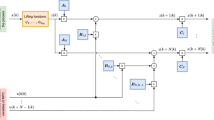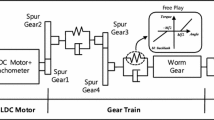Abstract
Purpose
It is observed that the motor-running machines that the fluctuation in power supply causes torsional vibration in the rotating systems. Estimation of torque helps in efficient operation of machines with limited sensors. Measurement noise and the effect of exogenous inputs in torque estimation are main problems.
Methods
Here, authors have used a Kalman filter-based input estimation technique for indirect estimation of torque variation in a rotating system. Two mathematical models of the rotating system are used in the present work. The estimation becomes unstable when degrees of freedom is more than the number of parameters to be estimated. For such scenario a modified approach, that consists of using a penalty is proposed. Experimental measurements are performed on a drivetrain to verify the proposed technique.
Results
Results are presented for different braking torques. It is found that the estimated torque is close to the measured torque. The effect of the penalty on estimation is studied. A stability analysis is performed with different values of penalty values. Finally, a sensitivity analysis is performed to check for the robustness of the algorithm.
Conclusions
It is found that the estimated torque converges to the measured torque with a higher penalty value. The estimator is found robust as the estimated torque matches well with the measured torque for different test cases. Sensitivity analysis shows that for more accurate estimation, accuracy of model stiffness is of the essence.















Similar content being viewed by others
References
Licari J, Ugalde-Loo CE, Ekanayake JB, Jenkins N (2012) Damping of torsional vibrations in a variable-speed wind turbine. IEEE Trans Energy Convers 28(1):172–180. https://doi.org/10.1109/tec.2012.2224868
Mohanty AR (2014) Machinery condition monitoring: Principles and practices. CRC Press, Boca Raton
Murakami T, Yu F, Ohnishi K (1993) Torque sensorless control in multidegree-of-freedom manipulator. IEEE Trans Industr Electron 40(2):259–265. https://doi.org/10.1109/41.222648
Liu Y, Zhu ZQ, Howe D (2006) Instantaneous torque estimation in sensorless direct-torque-controlled brushless DC motors. IEEE Trans Ind Appl 42(5):1275–1283. https://doi.org/10.1109/IAS.2005.1518743
Kalman RE (1960) A new approach to linear filtering and prediction problems. Trans ASME J Basic Eng 82:35–45. https://doi.org/10.1115/1.3662552
Chui CK, Chen G (2017) Kalman filtering. Springer International Publishing. https://doi.org/10.1007/978-3-540-87849-0
Khanam S, Dutt JK, Tandon N (2014) Extracting rolling element bearing faults from noisy vibration signal using Kalman filter. J Vib Acoust 10(1115/1):4026946
Shrivastava A, Mohanty AR (2018) Estimation of single plane unbalance parameters of a rotor-bearing system using Kalman filtering based force estimation technique. J Sound Vib 418:184–199. https://doi.org/10.1016/j.jsv.2017.11.020
Shrivastava A, Mohanty AR (2019) Identification of unbalance in a rotor-bearing system using Kalman filter–based input estimation technique. J Vib Control 26(11–12):1081–1091. https://doi.org/10.1177/1077546319891642
Shrivastava A, Mohanty AR (2019) Identification of unbalance in a rotor system using a joint input-state estimation technique. J Sound Vib 442:414–427. https://doi.org/10.1016/j.jsv.2018.11.019
Song X, Zhai H, Liang D (2019) Dynamic load identification and displacement prediction based on FBG for a cantilever beam. J Vib Eng Technol 7:131–137. https://doi.org/10.1007/s42417-019-00091-7
Lee SC , Ahn HS (2010) Sensorless torque estimation using adaptive Kalman filter and disturbance estimator. In: Proceedings of 2010 IEEE/ASME International Conference on mechatronic and embedded systems and applications, Qingdao, July, 2010, pp 87–92. IEEE. https://doi.org/10.1109/MESA.2010.5552094
Shrivastava A, Mohanty AR (2019) Kalman filter-based force estimation in a clamped plate using reduced order model and noisy measurements. Inverse Probl Sci Eng 27(8):1170–1193. https://doi.org/10.1080/17415977.2018.1503657
Chan YT, Hu AGC, Plant JB (1979) A Kalman filter based tracking scheme with input estimation. IEEE Trans Aerosp Electron Syst 2:237–244. https://doi.org/10.1109/TAES.1979.308710
Tuan PC, Ji CC, Fong LW, Huang WT (1996) An input estimation approach to on-line two-dimensional inverse heat conduction problems. Numer Heat Transfer 29(3):345–363. https://doi.org/10.1080/10407799608914986
Ma CK, Tuan PC, Lin DC, Liu CS (1998) A study of an inverse method for the estimation of impulsive loads. Int J Syst Sci 29(6):663–672. https://doi.org/10.1080/00207729808929559
Xie C, Hua L, Han X et al (2018) Analytical formulas for gear body-induced tooth deflections of spur gears considering structure coupling effect. Int J Mech Sci 148(05):174–190. https://doi.org/10.1016/j.ijmecsci.2018.08.022
Mohammad KS, Worden K, Tomlinson GR (1992) Direct parameter estimation for linear and non-linear structures. J Sound Vib 152(3):471–499. https://doi.org/10.1016/0022-460X(92)90482-D
Funding
No funding was received to assist with the preparation of this manuscript.
Author information
Authors and Affiliations
Corresponding author
Ethics declarations
Conflict of interests
The authors have no relevant financial or non-financial interests to disclose. The authors have no competing interests to declare that are relevant to the content of this article. All authors certify that they have no affiliations with or involvement in any organization or entity with any financial interest or non-financial interest in the subject matter or materials discussed in this manuscript. The authors have no financial or proprietary interests in any material discussed in this article.
Additional information
Publisher's Note
Springer Nature remains neutral with regard to jurisdictional claims in published maps and institutional affiliations.
Rights and permissions
Springer Nature or its licensor holds exclusive rights to this article under a publishing agreement with the author(s) or other rightsholder(s); author self-archiving of the accepted manuscript version of this article is solely governed by the terms of such publishing agreement and applicable law.
About this article
Cite this article
Mahapatra, S., Shrivastava, A., Sahoo, B. et al. Estimation of Torque Variation due to Torsional Vibration in a Rotating System Using a Kalman Filter-Based Approach. J. Vib. Eng. Technol. 11, 1939–1950 (2023). https://doi.org/10.1007/s42417-022-00681-y
Received:
Revised:
Accepted:
Published:
Issue Date:
DOI: https://doi.org/10.1007/s42417-022-00681-y




